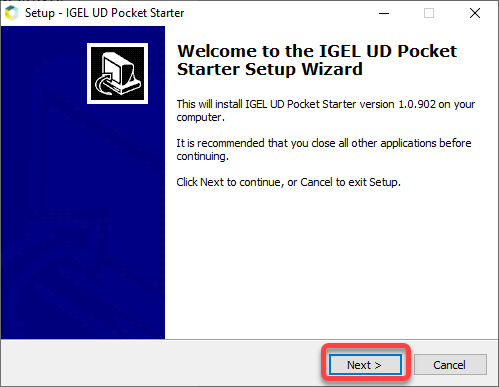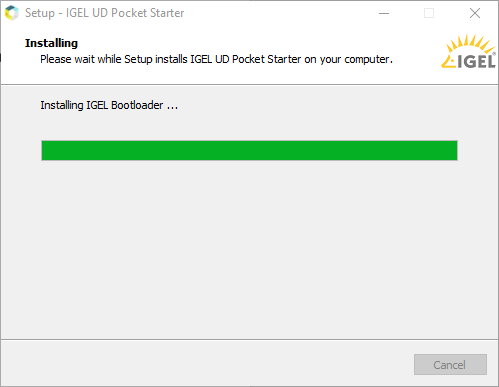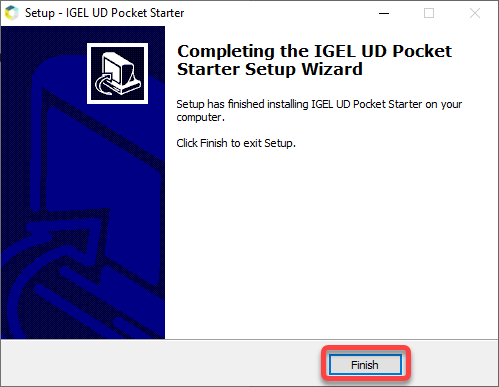Download PDF
Download page IGEL UD Pocket Manual.
IGEL UD Pocket Manual
UD Pocket boots IGEL OS on your computer. However, it does not make any changes to the operating system already installed on the hard disk, SSD, or flash storage – UD Pocket runs entirely from the USB stick.
To facilitate booting your UD Pocket, you can use the IGEL UD Pocket Starter. The IGEL UD Pocket Starter creates a boot option for the UD Pocket so that there is no need to change the boot settings manually. You can install the IGEL UD Pocket Starter easily on an endpoint device running Microsoft Windows 10 or 11 - provided Microsoft BitLocker ist not active on the device When you uninstall the IGEL UD Pocket Starter, it is removed without any trace on the device.
UD Pocket, like all IGEL operating systems, can be managed centrally using the IGEL Universal Management Suite (UMS). UD Pocket uses IGEL OS, which is described in detail in the IGEL OS Reference Manual.
UD Pocket has a partition that contains this manual and is readable under Windows. The manual describes setting up and starting UD Pocket on your computer.
This manual applies to UD Pocket and UD Pocket2.
Requirements
- For general hardware requirements and supported devices, see Devices Supported by IGEL OS 11.
- For components such as Ethernet or wireless adapters, see the IGEL Linux 3rd Party Hardware Database.
- If you want to use the IGEL UD Pocket Starter, the following requirements apply:
- Microsoft Windows 10 or 11 is installed on the endpoint device.
- Microsoft BitLocker is not activated on the endpoint device.
Installing the IGEL UD Pocket Starter
- Download the IGEL UD Pocket Starter from https://www.igel.com/software-downloads/
- Copy the file to your endpoint device, double-click it, and follow the instructions of the IGEL UD Pocket Starter Setup Wizard.




- Continue with Starting Your IGEL UD Pocket.
If You Are Not Using the IGEL UD Pocket Starter: Customizing the Boot Settings
UD Pocket works on systems with BIOS and UEFI.
It is essential that your system supports booting from USB storage media. This may already be enabled, or you may have to enable it yourself. The required key presses for this may vary from vendor to vendor. However, here are some hints:
![]() While the device is booting, try pressing [F12] (in general), [F10] (Intel devices), or [F9] (Hewlett-Packard devices) in order to access a list of boot devices and select UD Pocket.
While the device is booting, try pressing [F12] (in general), [F10] (Intel devices), or [F9] (Hewlett-Packard devices) in order to access a list of boot devices and select UD Pocket.
![]() If the above does not work, access the BIOS settings via pressing [Del], [F1], or [F2] during boot, activate booting from USB storage media, and/or change the boot order.
If the above does not work, access the BIOS settings via pressing [Del], [F1], or [F2] during boot, activate booting from USB storage media, and/or change the boot order.
![]() See the BIOS/UEFI documentation for your system for details on how to boot from USB storage media.
See the BIOS/UEFI documentation for your system for details on how to boot from USB storage media.
On modern computers such as secured-core PCs (see e.g. https://www.microsoft.com/en-us/windows/business/devices?col=secured-core-pcs), there may be a BIOS setting related to Secure Boot that allows the use of Microsoft’s 3rd party UEFI Secure Boot Certificate. The usual description of such a BIOS setting is "Allow Microsoft 3rd Party UEFI CA". This setting must be set to enabled, as IGEL uses the 3rd party certificate to support UEFI Secure Boot. If UEFI Secure Boot is enabled, but "Allow Microsoft 3rd Party UEFI CA" is not enabled, you may be unable to boot IGEL OS Creator or UD Pocket. Similarly, if the setting "Allow Microsoft 3rd Party UEFI CA" is disabled after a previous installation of IGEL OS, IGEL OS will fail to boot. For how to enable the setting, see Secured-Core PCs: Microsoft 3rd-Party UEFI Certificate for Secure Boot.
If UD Pocket fails to boot in UEFI mode, try it in legacy/BIOS mode. If this does not help, try another endpoint device to verify that the UD Pocket is functional and/or check for BIOS updates for your endpoint device and for the latest IGEL OS updates.
Starting Your IGEL UD Pocket
The First Boot Procedure
- Plug the UD Pocket into a free USB slot of your device.
- Turn on your device; if the device is already switched on, restart it.
After the First Boot-Up
The Setup Assistant guides you through the basic configuration. For a detailed description of each step, see Setup Assistant for IGEL OS.
Should the UD Pocket Boot-Up Fail
![]() If the device does not boot into UD Pocket, but into its pre-installed operating system instead, change the boot settings appropriately. For further information, see "Boot Settings" above.
If the device does not boot into UD Pocket, but into its pre-installed operating system instead, change the boot settings appropriately. For further information, see "Boot Settings" above.
IGEL Tech Video